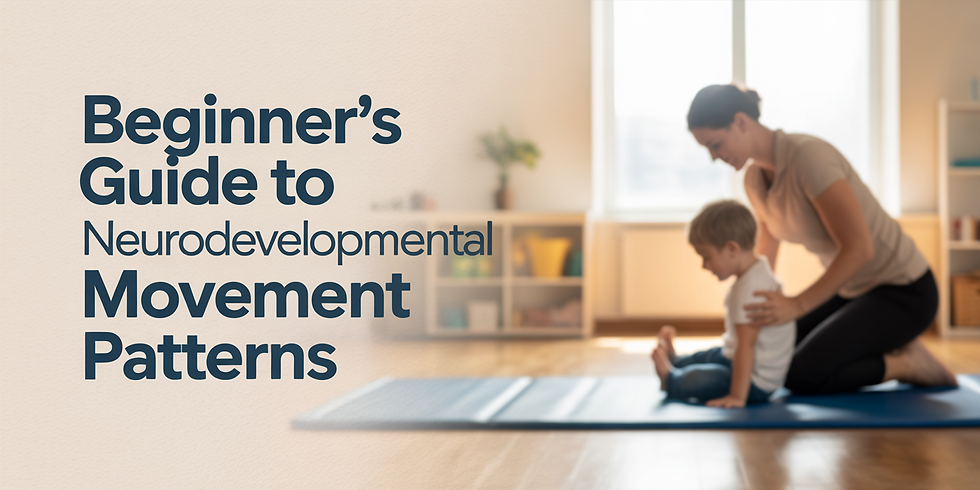Beginner’s Guide to Neurodevelopmental Movement Patterns
- ops62019
- Jul 10
- 8 min read

This guide will cover the essentials of neurodevelopmental movement patterns, including their importance, benefits, and practical applications for both children and adults. Whether you're a parent, educator, or someone curious about personal growth, understanding these movements can unlock new opportunities for development and well-being.
Introduction to Neurodevelopmental Movement
Neurodevelopmental movement refers to a series of natural, instinctive motions that form the foundation of early human development. These movements are essential for the maturation of the brain and nervous system, helping us achieve key milestones like rolling, crawling, and walking. They’re not just for babies—these patterns play a role in lifelong physical and cognitive health. By revisiting these foundational movements, individuals can tap into their body's innate ability to heal and grow.
For those with neurodevelopmental disorders such as ADHD, autism, or dyslexia, these movements can be particularly transformative. They help rewire the brain, fostering better focus, coordination, and emotional regulation. In essence, neurodevelopmental movements provide a bridge between the body and mind, paving the way for holistic development. This sets the stage for exploring how these movements work and why they matter so much.
How Neurodevelopmental Movements Work
At their core, neurodevelopmental movements support brain maturation by strengthening neural connections. When we engage in rhythmic, repetitive motions, our sensory systems light up, creating pathways that enhance learning and motor skills. Think of it as giving your brain a software update—it improves processing speed, memory, and overall function.
These movements also act as a reset button for developmental processes. For example, if primitive reflexes (automatic responses present at birth) don’t integrate properly, they can interfere with later skills like reading or balance. By practicing specific exercises, individuals can "reboot" these reflexes, leading to smoother cognitive and physical functioning. It's fascinating how something as simple as rocking back and forth can stimulate critical brain links!
Rhythmic movements are especially powerful because they mimic the natural flow of early childhood development. Activities like cross-crawling (moving opposite arm and leg together) activate both hemispheres of the brain, promoting better communication between them. This is why practices like yoga, dance, and even certain therapeutic techniques often incorporate similar motions—they harness the power of neurodevelopmental principles to boost performance and well-being. Now let’s dive deeper into one of the building blocks of these movements: primitive reflexes.
Primitive Reflexes and Neurodevelopmental Movements
Primitive reflexes are automatic responses present from birth, such as the Moro reflex (startle response) or the rooting reflex (turning toward touch near the mouth). While these reflexes typically fade during infancy, they lay the groundwork for more complex motor skills. However, if they persist beyond infancy, they can hinder development, contributing to challenges like poor posture or difficulty focusing.
Integrating primitive reflexes through targeted neurodevelopmental movements can lead to remarkable improvements. For instance, exercises that encourage head control or trunk stability can help refine balance and coordination. The result? Better learning outcomes, increased confidence, and enhanced overall development. Understanding this connection highlights the importance of mastering these foundational movements. Let’s now explore some common patterns of movement that everyone should know.
Common Patterns of Movement
There are four primary neurodevelopmental movement patterns: truncal, homologous, homolateral, and cross-pattern. Truncal movements involve flexion and extension of the torso, while homologous movements engage symmetrical actions of limbs, like clapping hands or jumping jacks. Homolateral patterns use the same-side arm and leg together, whereas cross-pattern movements coordinate opposite sides of the body.
These patterns emerge naturally during infancy and early childhood, guiding us through stages like crawling, creeping, and eventually walking. Each pattern plays a unique role in organizing the central nervous system, ensuring smooth transitions between developmental milestones. Without these patterns, achieving higher-level skills becomes challenging, underscoring their importance in neurological organization.
By revisiting these patterns later in life, we can address gaps in development or recover lost abilities due to injury or illness. For example, athletes might use cross-pattern drills to improve agility, while seniors may practice truncal movements to maintain balance. Recognizing these patterns helps us appreciate their versatility across ages and contexts. Next, let’s examine the many benefits these movements offer to both kids and adults alike.
Benefits for Children and Adults
For children, neurodevelopmental movements are like magic wands for growth. They enhance academic performance by improving focus and memory, boost self-esteem through mastery of new skills, and foster social interaction by encouraging group activities. Imagine a child who struggles with reading suddenly finding joy in books after practicing cross-lateral exercises—it happens more often than you’d think!
Adults aren’t left out either; these movements promote relaxation, reduce stress, and sharpen mental clarity. Practices like tai chi and Pilates draw heavily from the neurodevelopmental principles we use, proving their relevance across generations. Whether you’re looking to improve posture, increase energy levels, or simply feel more grounded, incorporating these movements into your routine can make a world of difference.
Even creative pursuits like dance and music rely on these fundamental patterns. Musicians benefit from enhanced hand-eye coordination, while dancers gain fluidity and grace. The applications are endless, making neurodevelopmental movements a universal tool for well-being. With all these perks, it’s no wonder people are eager to try them out. So, how exactly can you get started? Let’s find out!
Practical Applications
Getting started with neurodevelopmental movements is easier than you might think. Begin with simple exercises like baby crawling on all fours or rocking gently side to side. These movements awaken dormant neural pathways and prepare the body for more advanced activities. Consistency is key—even five minutes a day can yield noticeable results over time.
Integrating these movements into daily life doesn’t have to be complicated. Try doing a few stretches while watching TV, or incorporate cross-lateral motions into your morning workout. Therapists often use specialized programs tailored to individual needs, but anyone can adapt these principles for personal use. Ready to see how professionals apply these concepts in therapy? Let’s take a closer look.

Using Neurodevelopmental Movements in Therapy
In therapeutic settings, neurodevelopmental movements are used to address a wide range of challenges, from autism spectrum disorders to traumatic brain injuries. Therapists guide clients through specific exercises designed to target areas of weakness or dysfunction. For example, a child struggling with fine motor skills might practice grasping objects while performing rhythmic motions to strengthen neural connections.
Parents and caregivers also play a crucial role in implementing these strategies at home. Simple activities like bouncing on a therapy ball or playing catch can reinforce what’s learned in sessions. Collaboration between professionals and families ensures consistent progress, empowering individuals to reach their full potential. Success stories abound when these efforts align—let’s hear some inspiring examples next.
Case Studies and Success Stories
Take Sarah, a seven-year-old diagnosed with dyspraxia, who struggled with coordination and balance. After six months of regular neurodevelopmental movement therapy, she showed significant improvement in her ability to ride a bike and write neatly. Her parents noticed a newfound confidence that spilled over into other areas of her life.
Then there’s Mark, a 45-year-old recovering from a stroke. Through dedicated practice of truncal and cross-pattern movements, he regained mobility and independence. Stories like these highlight the transformative power of these techniques, offering hope to countless others facing similar challenges. As we continue, let’s explore the typical sequence of neurodevelopmental milestones and their significance.
Neurodevelopmental Sequence and Milestones
Babies follow a predictable sequence of movements as they grow: rolling, sitting, crawling, standing, and finally walking. Each milestone builds upon the last, developing strength, stability, and coordination along the way. Skipping any step can lead to developmental delays, which is why therapists often revisit these stages in rehabilitation settings.
For older individuals recovering from injuries or neurological conditions, mimicking this sequence can accelerate healing. For example, someone regaining leg strength might start with floor-based exercises before progressing to standing positions. Understanding this progression underscores the importance of respecting each phase of development. But did you know animal movements inspire some of these patterns? Let’s uncover the fascinating work of Bonnie Bainbridge Cohen next.
Her research on Basic Neurocellular Patterns reveals intriguing parallels between human infants and animals, shedding light on the universality of movement. This knowledge opens doors for personal transformation and growth. Shall we explore further?
Basic Neurocellular Patterns (BNP)
Bonnie Bainbridge Cohen’s groundbreaking work on BNP explores the similarities between infant and animal movement patterns. She discovered that humans share fundamental movement sequences with creatures like frogs, fish, and reptiles. These patterns serve as blueprints for optimal functioning, influencing everything from posture to emotional expression.
By studying and embodying these patterns, individuals can access deep layers of self-awareness and healing. Whether you’re seeking to overcome trauma or simply enhance your quality of life, BNP offers a pathway to transformation. Integrating these insights into daily routines can amplify the benefits of neurodevelopmental movements. Speaking of integration, here’s how you can weave these practices into everyday life.
Integrating Neurodevelopmental Movements into Daily Life
Making neurodevelopmental movements part of your daily routine doesn’t require drastic changes. Start small—add a few minutes of crawling to your morning stretch or practice cross-lateral motions during breaks at work. Over time, these habits become second nature, supporting long-term health and vitality.
Consistency and patience are vital. Don’t expect overnight miracles; instead, celebrate incremental progress. Remember, every movement counts toward rewiring your brain and nurturing your body. With dedication, you’ll soon experience the profound impact of these practices. However, it’s not always smooth sailing—let’s discuss some common hurdles next.
Challenges and Limitations
One challenge people face is sticking to the program. It’s easy to lose motivation when results aren’t immediate. Another obstacle is skepticism—some dismiss neurodevelopmental movements as pseudoscience without fully understanding their scientific basis. Addressing these concerns requires education and persistence.

While research supports the efficacy of these methods, there’s still room for exploration. More studies could clarify which populations benefit most and under what conditions. Acknowledging these limitations fosters realistic expectations and encourages ongoing investigation. Let’s tackle skepticism head-on and provide reassurance based on evidence.
Addressing Skepticism
Skepticism about neurodevelopmental movements is understandable, given the abundance of unverified wellness trends. However, numerous studies validate their effectiveness in improving motor skills, cognitive function, and emotional regulation. Institutions like Atlas Posture specialize in these techniques, offering expert guidance backed by science. Trustworthy resources ensure you’re investing in proven methodologies.
Resources for Further Learning
If you’re eager to dive deeper, check out books like The Brain That Changes Itself by Norman Doidge and online courses from reputable organizations. Websites like Atlas Posture provide valuable insights and tools for integrating neurodevelopmental movements into your life. Exploring these resources equips you with the knowledge to embark on your journey confidently.
FAQs
What are neurodevelopmental movement patterns? They are instinctive motions that support brain and nervous system development, forming the foundation for lifelong physical and cognitive health.
How do neurodevelopmental movements help with developmental disorders? By rewiring the brain and integrating primitive reflexes, these movements improve focus, coordination, and emotional regulation.
Can neurodevelopmental movements be practiced by adults? Absolutely! Adults benefit from improved posture, reduced stress, and enhanced mental clarity.
What are the most common patterns of movement in neurodevelopmental sequences? Truncal, homologous, homolateral, and cross-pattern movements are the primary types.
How can I start practicing neurodevelopmental movements at home? Begin with simple exercises like crawling or rocking, and gradually incorporate them into your daily routine.
Conclusion
Neurodevelopmental movement patterns hold immense potential for fostering growth, healing, and transformation. From enhancing cognitive abilities in children to promoting relaxation in adults, these movements offer something for everyone. By understanding and embracing these principles, you open doors to improved well-being and fulfillment.
Whether you choose to explore these practices independently or seek professional guidance, the journey promises rewarding outcomes. Visit Atlas Posture today to learn more about how neurodevelopmental movements can enrich your life. Your future self will thank you!
Ready to take the first step toward a healthier, happier you? Dive into the world of neurodevelopmental movement patterns and witness the incredible changes they can bring. You’ve got this!

